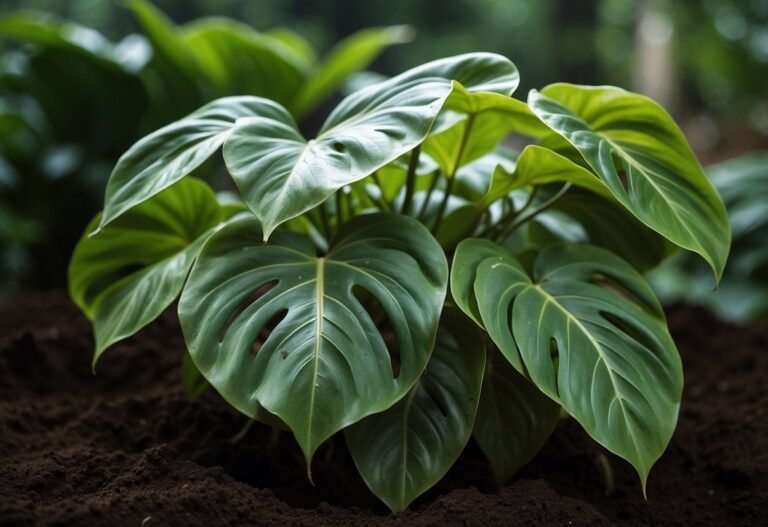Philodendron Selloum Leaves Curling: Causes and Effective Solutions
When I first noticed my Philodendron Selloum leaves curling, I wanted a quick and clear answer. Philodendron Selloum leaves curl when the plant is stressed by things like improper watering, low humidity, pests, or cold temperatures.
Seeing those beautiful, glossy leaves twist and fold is a clear sign that my plant needs help.

I’ve learned that getting to the root of the problem takes careful observation and a little patience. There are a few common reasons for leaf curling, and knowing what to look for can save time and keep your plant healthy.
Common Causes of Philodendron Selloum Leaves Curling

I’ve found that Philodendron Selloum leaves often start to curl because of their care environment. These changes in the plant’s leaves are almost always a sign of stress related to water, light, temperature, or humidity.
Underwatering and Overwatering
Watering problems are a top cause of leaf curling in Philodendron Selloum. Underwatering makes the soil too dry, forcing the plant to conserve water.
The leaves respond by curling up and may become dry or crispy at the edges. Overwatering is equally harmful.
When the roots sit in soggy soil, they can’t get enough oxygen. This can cause root rot, which leads to yellowing, limp, and curling leaves.
To avoid this, I check the moisture of the soil before I water the plant. A basic finger test or a moisture meter works well.
I water only when the top inch of soil feels dry to the touch. Consistency is important, as swings from very dry to very wet can make curling worse.
Improper Light Exposure
Philodendron Selloum prefers bright, indirect sunlight. If the plant sits in a spot that’s too shady, its growth slows down.
The leaves may stretch and curl in search of light. Direct sunlight, however, can scorch the leaves.
Too much light can cause yellow or brown spots and crispy, curling leaf edges. To keep my plant healthy, I place it near a window with filtered light or use sheer curtains.
This allows enough light in without causing stress or damage to the leaves. If I notice leaves turning pale or showing signs of burn, I move the plant to a less intense spot.
Proper placement helps maintain healthy, open leaves and overall strong growth.
Temperature Fluctuations
Philodendron Selloum thrives in stable, warm temperatures. Sudden drops in temperature or cold drafts can shock the plant.
The leaves may curl up tightly to protect themselves. If the plant is near a door, drafty window, or heater, it can suffer from these shifts.
Temperatures below 55°F (13°C) can cause curling and slowed growth. Rapid changes, like bringing the plant outdoors and back inside, can also trigger stress.
To keep my Selloum healthy, I choose a spot with stable temperatures. I avoid placing it close to air conditioners, radiators, or areas with cold drafts.
This helps create a consistent environment that keeps its leaves strong and flat.
Low Humidity Levels
Philodendron Selloum is native to tropical environments with high humidity. In dry indoor air, the leaves often curl to reduce water loss.
This can also make the edges look dry or shriveled. Most homes have humidity levels below what this plant prefers.
Ideal humidity is between 60–80%. I use a humidifier or place a tray of water and pebbles under the plant to help boost moisture.
Grouping plants together can also increase humidity through natural transpiration. I avoid placing the plant near vents or fans, as moving air can make the leaves curl even more.
For optimal growth, I aim to keep the air around my Selloum humid and stable. For more information on humidity, see this guide on Philodendron care.
Diagnosing Leaf Curling in Philodendron Selloum

When my Philodendron Selloum’s leaves start to curl, it’s often a signal of stress. This can be caused by environmental conditions, a lack of nutrients, or problems with the soil.
Identifying Environmental Stressors
I look for changes in light, temperature, and humidity that might stress my plant. Philodendron Selloum prefers bright, indirect sunlight and temperatures between 65°F and 80°F.
Cold drafts or heat from heaters can make leaves curl. If my plant is too close to a window in the winter or an air vent, the leaves may curl up from the cold air or constant airflow.
Low humidity is another issue. Philodendron Selloum is a tropical plant, so it needs higher humidity.
When the air is dry, especially indoors during winter, the tips or edges of the leaves tend to curl. To prevent this, I keep humidity around 60-80% using a humidifier or by grouping plants together.
For more details on environmental stress and leaf curling, I rely on trusted plant care guides.
Symptoms of Nutrient Deficiencies
A lack of key nutrients often causes leaf curling. If I notice leaves curling and turning yellow, I check for signs of nitrogen, magnesium, or potassium deficiency.
The leaves might look pale, with yellow edges, or have small brown spots. I monitor my plant’s growth and note if new leaves are smaller or more curled than older ones.
Sometimes, nutrient issues are linked to using plain water or poor-quality soil. I add a balanced, water-soluble fertilizer every month during the growing season to help prevent deficiencies.
I also watch for signs of improvement after feeding to confirm if lack of nutrients was the issue.
Assessing Soil Conditions
Poor soil can quickly result in leaf curling. Overwatering is a common mistake.
When soil stays wet for too long, roots can’t get enough oxygen. This stress causes the leaves to curl inward.
I let the top inch of soil dry before watering and use a moisture meter if needed. Signs that the soil is too compacted include slow drainage and a musty smell.
I use a loose, well-draining potting mix to support healthy roots. If the soil is waterlogged, I repot my plant in fresh soil and make sure the pot has drainage holes.
My approach follows advice from reputable resources like this guide on preventing water stress.
Effective Solutions and Preventive Measures
I have found that addressing Philodendron Selloum leaf curling involves careful management of water, light, humidity, and nutrients. Each factor requires specific actions to keep leaves open, healthy, and vibrant.
Watering Techniques
Maintaining proper watering habits is crucial. I use a moisture meter or test the soil by hand, ensuring I water only when the top 2 to 3 inches feel dry.
This helps me avoid both overwatering and underwatering, which are common reasons for leaf curling. I also choose pots with drainage holes.
Good drainage lets excess water escape, keeping roots healthy. I avoid letting the plant sit in standing water, as that can lead to root rot and curled leaves.
Keeping a consistent schedule helps my plant adjust and thrive. I record each watering and observe how quickly the soil dries out, especially when temperatures or humidity change seasonally.
Optimal Lighting Conditions
Providing the right amount of light is essential for Philodendron Selloum. I place my plant in an area with bright, indirect sunlight to prevent leaf scorch and curling.
Too much direct sun can burn the leaves, while too little makes them weak and prone to curling. I move my plant seasonally to adjust for changes in natural sunlight.
For example, in winter, I may move it closer to a window. In summer, I provide shade if afternoons are especially bright and harsh.
If natural light is insufficient, I sometimes use a grow light to supplement. Monitoring the leaf color and posture helps alert me to any problems with lighting conditions.
More details are available on proper lighting for Philodendrons.
Enhancing Humidity
Philodendron Selloum benefits from higher humidity levels. I check the room’s humidity with a digital gauge, aiming for readings between 50% and 60%.
When the air is too dry, leaves may curl at the edges or droop. I raise humidity by using a room humidifier, placing the plant on a pebble tray, or grouping it with other houseplants.
I avoid misting directly onto the leaves as it can sometimes encourage fungal issues. Here’s a quick table showing methods I use to increase humidity:
| Method | Ease of Use | Effectiveness |
|---|---|---|
| Humidifier | High | High |
| Pebble Tray | Medium | Medium |
| Grouping Plants | Easy | Moderate |
Nutrient Management
A balanced fertilizer keeps my Philodendron Selloum strong and healthy. I use a water-soluble fertilizer with equal parts nitrogen, phosphorus, and potassium, applying it once a month during the growing season.
I reduce feeding in winter, when the plant grows more slowly. I check leaves for signs of deficiency, such as yellowing or weak, curled edges.
If I see issues, I review my feeding schedule and sometimes switch fertilizers. Instructions on the package are important to follow exactly, because over-fertilizing can also cause leaf curling.
Nutrient management is especially important if I notice new leaves are smaller than normal or if growth stalls. More information on nutrient and soil issues can be found at fixing Philodendron Selloum leaf curling.
Frequently Asked Questions
Leaf curling in my Philodendron Selloum may be caused by several factors, including water issues, humidity, and environmental changes. Noticing symptoms like yellowing, drooping, or browning alongside curling helps me figure out the root issue and the best solution.
Why are my Philodendron Selloum leaves turning yellow and curling?
When I see yellow and curling leaves, it usually means either overwatering or poor drainage. Too much water can cause root rot, which shows up in the leaves.
Sometimes, a lack of nutrients or exposure to cold drafts causes yellowing as well.
What causes Philodendron Selloum leaves to curl inward?
Most times, inward curling happens when my plant is too dry or the air is lacking in humidity. Tropical plants like Philodendron Selloum prefer moist air.
Cold temperatures or drafts may also lead to inward leaf curling, making my Selloum uncomfortable in its environment. More info is available on why Philodendron leaves curl.
How can I address browning and curling leaves on my Philodendron Selloum?
If I notice browning and curling at the tips or edges of leaves, I often increase humidity by misting the plant or placing it near a humidifier. It’s important to check for dry soil as well and water if it’s too dry.
Browning can also result from too much direct sunlight, so I keep mine in bright, indirect light. More suggestions can be found on how to handle browning and curling leaves.
What should I do if my Philodendron Selloum leaves start curling after repotting?
After repotting, leaf curling usually means my plant is stressed by changes in its environment. I make sure I didn’t damage the roots and use a pot with good drainage.
I try not to overwater after repotting and keep the plant in stable conditions until it adjusts.
What are the care tips for preventing curly leaves in Philodendron Selloum?
To keep my plant healthy, I maintain consistent moisture without letting the soil get soggy. I mist the leaves and sometimes use a pebble tray for extra humidity.
Keeping my Philodendron away from cold drafts and direct heat sources is also important. Regular care like this helps prevent leaves from curling.
More detailed humidity tips can be found here.
Why are my Philodendron Selloum leaves drooping and curling?
When my leaves droop and curl at the same time, I look for signs of either under-watering or root problems. Under-watering dries the leaves, while root rot from too much water leads to a lack of support.
I check the soil moisture and consider recent care changes to solve the problem.



